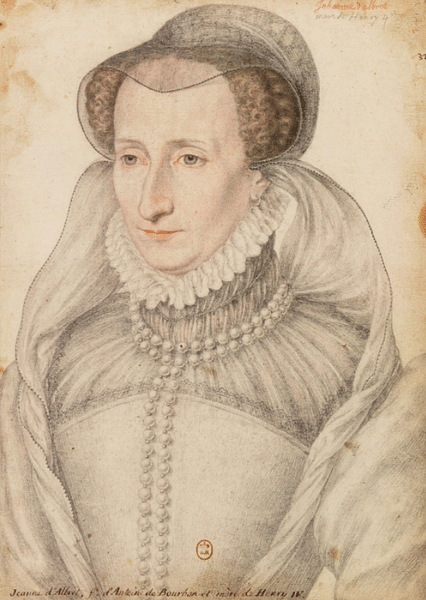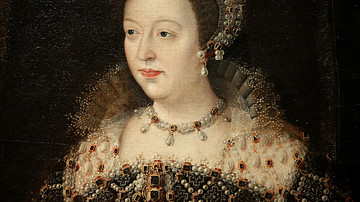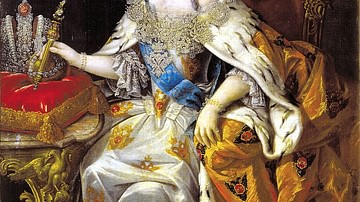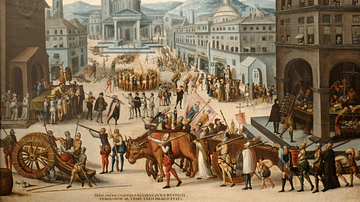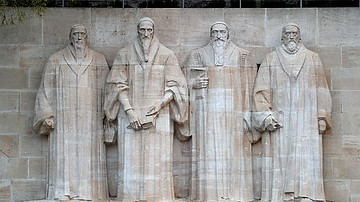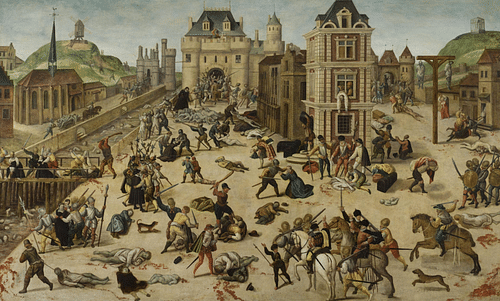
The St. Bartholomew's Day Massacre was a widespread slaughter of French Protestants (Huguenots) by Catholics beginning on 24 August 1572 and lasting over two months, resulting in the deaths of between 5,000 and 25,000 people. It began in Paris when the Catholic faction, fearing a Huguenot uprising, assassinated the leading Protestants who were there for a royal wedding.
The massacre erupted after years of religious tension in France, beginning with the spread of the 'new teachings' of the Protestant Reformation c. 1521, worsening after the 1534 Affair of the Placards, and becoming armed conflict in 1562, setting off the French Wars of Religion (1562-1598). The third war concluded in 1570 with the Peace of Saint-Germain-en-Laye, negotiated by the Protestant Queen of Navarre, Jeanne d'Albret (l. 1528-1572), and the Catholic Queen Mother of France, Catherine de' Medici (l. 1519-1589). In the hopes of establishing peace, a marriage was arranged between Catherine's Catholic daughter Margaret of Valois (l. 1553-1615) and d'Albret's Protestant son, Henry of Navarre (later King Henry IV of France, l. 1553-1610).
The wedding took place in Paris, drawing a large assembly from around the country, including Protestant leaders. Paris was a Catholic city, and the influx of a large Protestant crowd for the festivities elevated tensions. These came to a head a few days after the wedding, when Gaspard II de Coligny, Admiral of France (l. 1519-1572), a leading Protestant, was wounded in an assassination attempt. The Protestants voiced their outrage and, fearing an uprising, Catherine de' Medici and her son Charles IX of France (r. 1560-1574), along with the city council, authorized the execution of Protestant leaders. Coligny was the first killed on 24 August, with others following quickly.
The assassinations of the leaders encouraged the people of Paris to follow suit, and Protestants were hunted down and killed house by house and district by district. Charles IX called for peace, but by that time, the massacre was out of anyone's control. News of the slaughter spread quickly from Paris, inspiring the same in other cities. The event is regarded as among the worst religious massacres in history, igniting the fourth of the French Wars of Religion and leaving thousands dead.
Background & French Wars
The Protestant Reformation (1517-1648), launched by Martin Luther (l. 1483-1546) in the Germanic territories of the Holy Roman Empire, had reached France by c. 1521, causing divisions over the 'new teachings' which challenged the traditional authority of the Catholic Church. King Francis I of France (François I, r. 1515-1547), a Catholic, tolerated the Protestant presence largely due to the influence of his sister Marguerite de Navarre (l. 1492-1549) who, though also Catholic, sympathized with the Protestant cause.
Francis I's policy changed dramatically after the Affair of the Placards, 17-18 October 1534, when Protestant activists mounted placards denouncing the Catholic Mass in public places throughout five cities, including Paris. Francis I reversed his policy of toleration and authorized persecution of the Protestant faction. His son and successor, Henry II of France (r. 1547-1559), continued these policies until he died in a jousting accident in 1559. He was succeeded by his young son Francis II of France (François II, r. 1559-1560) who, though old enough to rule on his own at the age of 15, was controlled by his mother, Catherine de' Medici, who then allowed two Catholic nobles, Francis, Duke of Guise (l. 1519-1563), and his brother Charles, Cardinal of Lorraine (l. 1524-1574), to counsel the young king.
The Guise brothers quickly alienated Francis II from his former advisors who included two prominent Protestants: Admiral Coligny and Louis de Bourbon, Prince of Condé (l. 1530-1569). In 1560, both men were involved in the Amboise conspiracy to kidnap Francis II in an effort to free him from the control of the Guise, but the plot was uncovered, and the conspirators, including Condé but not Coligny, were jailed, while many suspected were executed outright. The Guise brothers presented the conspiracy to the public as an attempt by Protestants to overthrow the monarchy, heightening tensions further.
In 1560, Francis II died of an ear infection and was succeeded by his brother Charles IX. Catherine de' Medici quickly asserted control over her son, barring the Guise from their former role, and essentially ruled through him. She negotiated the release of Condé from prison through the pledge of his brother, Antoine de Bourbon (l. 1518-1562, Catholic husband of the Protestant Jeanne d'Albret) to renounce his legitimate claim as regent to Charles IX. With the Guise sidelined, Catherine attempted a moderate approach toward Protestants, inviting the former counselors to the king to return to court, including Condé and Coligny.
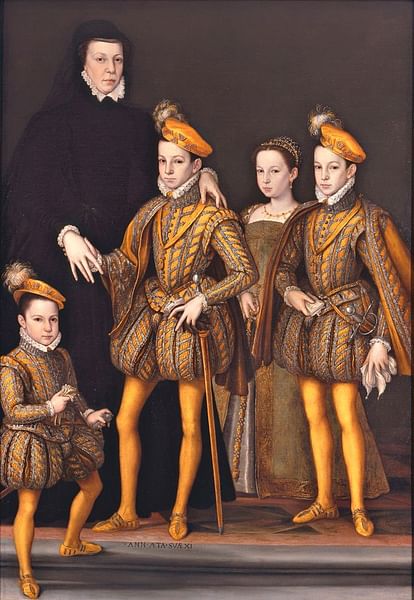
The queen's policy of toleration did not extend far beyond the palace, however, and tensions erupted in March 1562 when Francis, Duke of Guise sent his men to break up a Protestant worship service and wound up killing at least 50 congregants in the Massacre of Vassy, which began the French Wars of Religion. Condé retaliated by seizing the city of Orléans for the Protestants in April 1562, and the war expanded afterwards.
First Three Wars & Coligny
Jeanne d'Albret had outlawed Catholicism in her kingdom of Navarre and expelled the clergy in 1561 while, that same year, her husband, Antoine de Bourbon, had been appointed Lieutenant-General of France by Catherine de' Medici and charged with keeping the peace, which essentially meant suppressing Protestant initiatives. When the war broke out, d'Albret quietly financed the Protestant cause while Antoine fought for the Catholic faction. Coligny, though obviously sympathetic to the Protestants, was reluctant to lead forces against those backed by the crown and remained at court, councilor to Charles IX.
Catherine de' Medici resented Coligny's influence over her son but could do nothing about it without compromising her official policy of religious toleration. Coligny remained at court throughout the first war (1562-1563) during which both Antoine de Bourbon and Francis, Duke of Guise, were killed. This conflict was ended by Catherine de' Medici with support from Jeanne d'Albret, but the second war erupted in 1567 due to Protestant fears of Catholic reprisals for the first war. This same year, Charles IX was ambushed by Protestant forces in the event known as the Surprise of Meaux, causing Catherine to abandon her policy of toleration and advocate for the persecution of the Protestants.
A truce to the second war (1567-1568) was only briefly concluded before the third war (1568-1570) broke out during which Condé was killed and Coligny left the court to lead Protestant forces with the financial assistance and political backing of d'Albret, who (as she had earlier) drew on the resources of the Protestant Queen Elizabeth I of England (r. 1558-1603). Hostilities were ended with the Peace of Saint-Germain-en-Laye, negotiated by d'Albret and de' Medici, which pleased neither faction. The Protestants felt they were not given enough religious freedom, while the Catholics claimed they had been given too much.
Wedding & Assassination Attempt
Although she had no love for the Protestant cause, Catherine de' Medici recognized it was in the best interests of France to end the religious wars and suggested to Jeanne d'Albret the marriage of d'Albret’s son, Henry of Navarre, to Catherine's daughter, Margaret of Valois. This would unite a Protestant and a Catholic in marriage as well as the Kingdom of Navarre and France. Jeanne d'Albret initially rejected the suggestion but finally agreed while the Catholic faction, with the backing of the pope, denounced the proposal as it would join a Catholic to a heretic.
The Council of Trent (1545-1563) had decreed the Protestant Reformation a heresy, and there could be no union between a Christian as defined by the Council and a heretic in keeping with the biblical injunction from II Corinthians 6:14: "Be ye not unequally yoked together with unbelievers; for what fellowship hath righteousness with unrighteousness? And what communion hath light with darkness?" Still, Catherine saw the marriage as a way forward, and although she was opposed by the Catholic faction, now led by Henry I, Duke of Guise (l. 1550-1588, son of Francis, Duke of Guise), and the French Parlement, she had the wedding date set for 18 August 1572. Although later Protestant writers would claim that she staged the wedding to draw Protestants to Paris for the massacre, there is no evidence to support this.
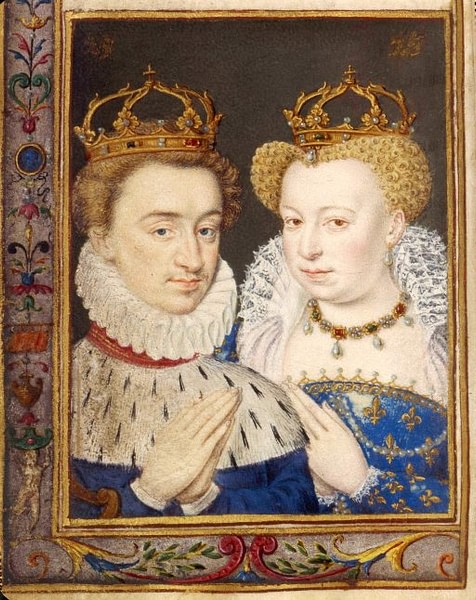
Jeanne d'Albret arrived early in the city and died of natural causes, probably tuberculosis, on or around 9 June. Catherine de' Medici was also accused of engineering this death through poisoned gloves, but, again, there is no evidence for the claim. Catherine organized a royal wedding with all the traditional pageantry which, in light of poor harvests that year and high taxes, only increased tension among the general population which was having a hard enough time just feeding itself.
By the time of the wedding, the Dutch Revolt (also known as the Eighty Years' War (1568-1648) had begun, which was informed by religious disagreement between Catholics and Protestants and threatened to draw France into the conflict. The Duke of Alba (l. 1507-1582), governor of the Netherlands for the Catholic Spanish King Philip II, took a hardline policy on Protestant activity and advocated their arrest and execution; a policy many Catholics in France agreed with. Alba's policy was nothing new, however, as it had been circulating among French Catholic nobles as early as 1560 if not before. Paris was a staunchly Catholic city and objected to the sudden influx of Protestants and, further, the grand welcome the Protestant leaders received when, according to Alba's policies, they should have been executed.
All of these factors contributed to the high tensions in the city when a few days following the wedding, on 22 August, an attempt was made on Coligny as he walked back to his apartments. An unknown assassin fired on him from an upper window, wounding him in the arm and hand. Coligny was carried to his bed where he was tended to and received assurances from Catherine de' Medici that his would-be assassin would be caught and punished, but this did nothing to quell the outrage of the other Protestant leaders, and at this point, the tension reached its peak. Scholar Diarmaid MacCulloch comments:
At this stage, with the atmosphere explosive, any wrong move spelled disaster, and everyone made the wrong move. The Huguenot leaders reluctantly agreed to stay in Paris, accepting royal assurances of protection: however, the royal Council was so unnerved by Huguenots' fury at the attempt on Coligny that it decided that a pre-emptive strike against them was the only safe thing to do. The young King Charles IX and Queen Catherine backed the Council's scheme, and on Sunday 24 August, St. Bartholomew's Day, royal troops, following the King's orders, murdered the Huguenot leaders still in the capital. (338)
The Massacre in Paris
The slaughter began with Coligny who was struck down in his apartment and thrown out the window into the street below, where he was beheaded, and his corpse was dragged through the street and then hung up by its feet. Soldiers wearing hats with the sign of the cross sewn on the front then dispatched the other Protestant leaders. MacCulloch continues:
When news spread, Catholic extremists in the city, who loathed everything that the Protestants stood for, gleefully took up this example of their social superiors: three days of the most savage killings and mutilations of known Protestants followed, and over the next few weeks, they were repeated in major cities throughout the kingdom. (338)
Catholics moved house to house, then street to street through the districts, killing Protestants and known Protestant sympathizers and then looting their homes. Charles IX issued a call for restraint and peace, but the massacre, once set in motion, took on a life and force of its own that no one could stop. Protestants who had early warning hid in attics, basements, and lofts. There was no escape from the city because Charles IX had ordered the gates locked the night before. Paris, therefore, became a great killing field in which thousands were murdered, the low toll placed at 5,000, but a final tally impossible to tell because so many corpses were thrown into the Seine and carried away downstream.
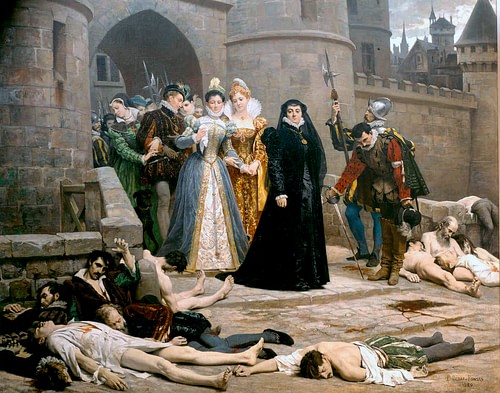
Primary Cause
Many factors contributed to the St. Bartholomew's Day Massacre, but primarily, it was caused by people's religious identification which had become increasingly divisive as the Protestant Reformation moved forward. Prior to 1517, there was only one Christian church, and Europeans who identified as Catholic were united under its teachings. Those who questioned the medieval Church's authority were branded heretics, ostracized, arrested, and often executed. Luther introduced the possibility of another vision of Christianity, which could be considered equally valid, and after him, Huldrych Zwingli (l. 1484-1531), the Anabaptists, and John Calvin (l. 1509-1564) established their own versions of the Christian faith, differing from Luther's, but claiming the same authority he and the Catholic Church had.
Councils were convened, both Protestant and Catholic, as well as attempts at ecumenical compromise, between 1522-1572 defining what it meant to be a Christian, but no agreement was ever reached between differing factions, the closest being the Peace of Augsburg in 1555, which decreed each ruler could determine the religious confession of their own territory. Even considering the Peace of Augsburg as a kind of reconciliation (which it was not, really), each faction insisted on their own confession of faith, which they held to be irrefutably true and identified with closely. MacCulloch notes:
Gradually, ordinary people were beginning to own the religious labels that the officially agreed confessions and the decisions of councils were creating: they found that they were Protestant, Catholic, Lutheran, Reformed. They were proud of these identities, and they often grew to hate people of different religious opinions. (338)
Once people began identifying with a certain Christian sect, anyone belonging to another was viewed negatively. The Anabaptists were inspired by the teachings of Zwingli, but once they formed their own sect, they were persecuted by him and his followers. Luther's movement splintered before 1522, as two of his early adherents, Thomas Müntzer (l. c. 1489-1525) and Andreas Karlstadt (l. 1486-1541) developed their own interpretations of Christianity. In France, where the Reformation never found the reception it had in the Germanic regions or in Switzerland, the people identified as either Catholic or Huguenot, and, as with the different Protestant sects elsewhere, they felt justified in persecuting those who held different beliefs.
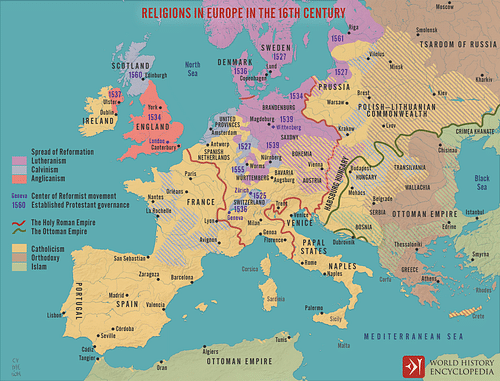
Conclusion
Without the sharp religious distinctions, which admitted no compromise, St. Bartholomew's Day Massacre could never have happened. The religious unity of the pre-Reformation period had been replaced by an endlessly repeating paradigm of 'us' vs. 'them' as the 'new teachings' spread further. St. Bartholomew's Day Massacre was not the first time Europeans had slaughtered each other in the name of religion and would not be the last, but it was the most dramatic and appalling up to that date. MacCulloch writes:
The shockwaves reverberated around Europe: governments trying to conduct normal diplomacy across the religious divide realized that suddenly the rules of international relations had been changed as decisively and negatively as the Peace of Augsburg had brought some positive stability and mutual acceptance. (339)
After the St. Bartholomew's Day Massacre, it was understood more clearly by governments that they would need to take the religious beliefs of other nations into closer consideration in their various associations. In France, the Protestant population diminished significantly not only through the thousands killed, but the many others who fled the country or converted to Catholicism. The massacre launched the fourth conflict of the French Wars of Religion, and hostilities would continue until 1598 when they were ended by the Edict of Nantes. This edict only concluded one chapter in the religious turmoil of Europe in the 16th and 17th centuries, however, it did not resolve the conflict; as the Thirty Years' War (1618-1648), informed by religious differences and understood as one of the most destructive wars in European history, would abundantly prove.
